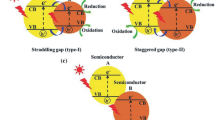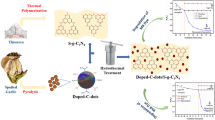Abstract
Although Bi3O4Cl is a kind of semiconductor catalyst driven by visible light, which possesses a layered structure and high chemical stability; however, the fast recombination of electron–hole pairs still limits its photocatalytic activity. In this work, the heterojunction combined Bi3O4Cl and Bi4NbO8Cl with a particle size of about 30–70 nm is constructed by a solid-state reaction method to improve the photocatalytic performance. XRD, TEM, XPS, and some other measurements are used to characterize the structure, morphology, and optical properties of the samples. Compared with Bi3O4Cl, the Bi3O4Cl/Bi4NbO8Cl Z-scheme photocatalyst shows a better photocatalytic performance, with 80% removal for ciprofloxacin (CIP) and 78% for bisphenol A (BPA) after 3-h illumination.








Similar content being viewed by others
References
Jiang E, Liu X, Che H, Liu C, Dong H, Che G (2018) Visible-light-driven Ag/Bi3O4Cl nanocomposite photocatalyst with enhanced photocatalytic activity for degradation of tetracycline. RSC Adv 8(65):37200–37207. https://doi.org/10.1039/c8ra07482h
Habibi-Yangjeh A, Feizpoor S, Seifzadeh D, Ghosh S (2020) Improving visible-light-induced photocatalytic ability of TiO2 through coupling with Bi3O4Cl and carbon dot nanoparticles. Sep Purif Technol 238:116404. https://doi.org/10.1016/j.seppur.2019.116404
Qu J, Du Y, Feng Y, Wang J, He B, Du M, Liu Y, Jiang N (2020) Visible-light-responsive K-doped g-C3N4/BiOBr hybrid photocatalyst with highly efficient degradation of Rhodamine B and tetracycline. Mater Sci Semicond Process 112:105023. https://doi.org/10.1016/j.mssp.2020.105023
Huang H, Han X, Li X, Wang S, Chu PK, Zhang Y (2015) Fabrication of multiple heterojunctions with tunable visible-light-active photocatalytic reactivity in BiOBr-BiOI full-range composites based on microstructure modulation and band structures. ACS Appl Mater Interfaces 7(1):482–492. https://doi.org/10.1021/am5065409
Cheng H, Huang B, Dai Y (2014) Engineering BiOX (X = Cl, Br, I) nanostructures for highly efficient photocatalytic applications. Nanoscale 6(4):2009–2026. https://doi.org/10.1039/c3nr05529a
Wu L, Zhang Q, Li Z, Liu X (2020) Mechanochemical syntheses of a series of bismuth oxyhalide composites to progressively enhance the visible-light responsive activities for the degradation of bisphenol-A. Mater Sci Semicond Process 105:104733. https://doi.org/10.1016/j.mssp.2019.104733
Meng X, Zhang Z (2018) New insight into BiOX (X = Cl, Br, and I) hierarchical microspheres in photocatalysis. Mater Lett 225:152–156. https://doi.org/10.1016/j.matlet.2018.04.086
Li J, Li H, Zhan G, Zhang L (2017) Solar water splitting and nitrogen fixation with layered bismuth oxyhalides. Acc Chem Res 50(1):112–121. https://doi.org/10.1021/acs.accounts.6b00523
Wang Z, Chen M, Huang D, Zeng G, Xu P, Zhou C, Lai C, Wang H, Cheng M, Wang W (2019) Multiply structural optimized strategies for bismuth oxyhalide photocatalysis and their environmental application. Chem Eng J 374:1025–1045. https://doi.org/10.1016/j.cej.2019.06.018
Xiong J, Song P, Di J, Li H (2020) Bismuth-rich bismuth oxyhalides: a new opportunity to trigger high-efficiency photocatalysis. Journal of Materials Chemistry A 8(41):21434–21454. https://doi.org/10.1039/d0ta06044e
Lou Z, Wang P, Huang B, Dai Y, Qin X, Zhang X, Wang Z, Liu Y (2017) Enhancing charge separation in photocatalysts with internal polar electric fields. ChemPhotoChem 1(5):136–147. https://doi.org/10.1002/cptc.201600057
Liu H, Zhou H, Liu X, Li H, Ren C, Li X, Li W, Lian Z, Zhang M (2019) Engineering design of hierarchical g-C3N4@Bi/BiOBr ternary heterojunction with Z-scheme system for efficient visible-light photocatalytic performance. J Alloy Compd 798:741–749. https://doi.org/10.1016/j.jallcom.2019.05.303
Ning S, Ding L, Lin Z, Lin Q, Zhang H, Lin H, Long J, Wang X (2016) One-pot fabrication of Bi3O4Cl/BiOCl plate-on-plate heterojunction with enhanced visible-light photocatalytic activity. Appl Catal B 185:203–212. https://doi.org/10.1016/j.apcatb.2015.12.021
Cui Z, Dong X, Sun Y, Zhou Y, Zhang Y, Dong F (2018) Simultaneous introduction of oxygen vacancies and Bi metal onto the 001 facet of Bi3O4Cl woven nanobelts for synergistically enhanced photocatalysis. Nanoscale 10(35):16928–16934. https://doi.org/10.1039/c8nr05322g
Che H, Che G, Dong H, Hu W, Hu H, Liu C, Li C (2018) Fabrication of Z-scheme Bi3O4Cl/g-C3N4 2D/2D heterojunctions with enhanced interfacial charge separation and photocatalytic degradation various organic pollutants activity. Appl Surf Sci 455:705–716. https://doi.org/10.1016/j.apsusc.2018.06.038
You Y, Wang S, Xiao K, Ma T, Zhang Y, Huang H (2018) Z-Scheme g-C3N4/Bi4NbO8Cl heterojunction for enhanced photocatalytic hydrogen production. ACS Sustain Chem Eng 6(12):16219–16227. https://doi.org/10.1021/acssuschemeng.8b03075
Xu Y, You Y, Huang H, Guo Y, Zhang Y (2020) Bi4NbO8Cl 001 nanosheets coupled with g-C3N4 as 2D/2D heterojunction for photocatalytic degradation and CO2 reduction. J Hazard Mater 381:121159. https://doi.org/10.1016/j.jhazmat.2019.121159
Ogawa K, Nakada A, Suzuki H, Tomita O, Higashi M, Saeki A, Kageyama H, Abe R (2019) Flux synthesis of layered oxyhalide Bi4NbO8Cl photocatalyst for efficient Z-scheme water splitting under visible light. ACS Appl Mater Interfaces 11(6):5642–5650. https://doi.org/10.1021/acsami.8b06411
Fujito H, Kunioku H, Kato D, Suzuki H, Higashi M, Kageyama H, Abe R (2016) Layered perovskite oxychloride Bi4NbO8Cl: a stable visible light responsive photocatalyst for water splitting. J Am Chem Soc 138(7):2082–2085. https://doi.org/10.1021/jacs.5b11191
Qu X, Liu M, Zhang W, Sun Z, Meng W, Shi L, Du F (2020) A facile route to construct NiTiO3/Bi4NbO8Cl heterostructures for enhanced photocatalytic water purification. J Mater Sci 55(22):9330–9342. https://doi.org/10.1007/s10853-020-04664-w
Huang Y, He Y, Cui M, Nong Q, Yu J, Wu F, Meng X (2016) Synthesis of AgCl/Bi3O4Cl composite and its photocatalytic activity in RhB degradation under visible light. Catal Commun 76:19–22. https://doi.org/10.1016/j.catcom.2015.12.018
Kunioku H, Higashi M, Tomita O, Yabuuchi M, Kato D, Fujito H, Kageyama H, Abe R (2018) Strong hybridization between Bi-6s and O-2p orbitals in Sillén-Aurivillius perovskite Bi4MO8X (M = Nb, Ta; X = Cl, Br), visible light photocatalysts enabling stable water oxidation. J Mater Chem A 6(7):3100–3107. https://doi.org/10.1039/c7ta08619a
Lin X, Huang T, Huang F, Wang W, Shi J (2007) Photocatalytic activity of a Bi-based oxychloride Bi4NbO8Cl. J Mater Chem 17(20):2145–2150. https://doi.org/10.1039/b615903f
Zhong J, Li J, Wang T, Zeng J, Si Y, Cheng C, Li M, Wang P, Ding J (2015) Improved solar-driven photocatalytic performance of Ag3PO4/ZnO composites benefiting from enhanced charge separation with a typical Z-scheme mechanism. Appl Phys A 122(1):4. https://doi.org/10.1007/s00339-015-9516-2
Hu Z, Chen D, Zhan X, Wang F, Qin L, Huang Y (2017) Synthesis of Ag-loaded SrTiO3/TiO2 heterostructure nanotube arrays for enhanced photocatalytic performances. Appl Phys A 123(6):399. https://doi.org/10.1007/s00339-017-1014-2
Zheng L, Wang S, Zhao L, Zhao S (2016) Core/shell Fe3O4/BiOI nanoparticles with high photocatalytic activity and stability. J Nanopart Res 18(11):318. https://doi.org/10.1007/s11051-016-3636-2
Qiu S, Wang W, Yu J, Tian X, Li X, Deng Z, Lin F, Zhang Y (2022) Enhanced photocatalytic degradation efficiency of formaldehyde by in-situ fabricated TiO2/C/CaCO3 heterojunction photocatalyst from mussel shell extract. J Solid State Chem 311:123110. https://doi.org/10.1016/j.jssc.2022.123110
Xu B, Gao Y, Li Y, Liu S, Lv D, Zhao S, Gao H, Yang G, Li N, Ge L (2020) Synthesis of Bi3O4Cl nanosheets with oxygen vacancies: The effect of defect states on photocatalytic performance. Appl Surf Sci 507:144806. https://doi.org/10.1016/j.apsusc.2019.144806
Du M, Zhang S, Xing Z, Li Z, Chen P, Pan K, Zhou W (2020) Dual plasmons-promoted electron-hole separation for direct Z-scheme Bi3O4Cl/AgCl heterojunction ultrathin nanosheets and enhanced photocatalytic-photothermal performance. J Hazard Mater 384:121268. https://doi.org/10.1016/j.jhazmat.2019.121268
Sun X, Zhang H, Wei J, Yu Q, Yang P, Zhang F (2016) Preparation of point-line Bi2WO6@TiO2 nanowires composite photocatalysts with enhanced UV/visible-light-driven photocatalytic activity. Mater Sci Semicond Process 45:51–56. https://doi.org/10.1016/j.mssp.2016.01.015
Yu F, Liu Z, Li Y, Nan D, Wang B, He L, Zhang J, Tang X, Duan H, Liu Y (2020) Effect of oxygen vacancy defect regeneration on photocatalytic properties of ZnO nanorods. Appl Phys A 126(12):931. https://doi.org/10.1007/s00339-020-04117-w
Majumdar A, Pal A (2020) Optimized synthesis of Bi4NbO8Cl perovskite nanosheets for enhanced visible light assisted photocatalytic degradation of tetracycline antibiotics. J Environ Chem Eng 8(1):103645. https://doi.org/10.1016/j.jece.2019.103645
Shi J-W, Liu C, Ai H-Y, Chen J-W, Xie C, Li G, Yang S, Li S (2015) One step to synthesize the nanocomposites of graphene nanosheets and N-doped titania nanoplates with exposed 001 facets for enhanced visible-light photocatalytic activity. J Nanopart Res 17(5):223. https://doi.org/10.1007/s11051-015-3014-5
He F, Chen G, Miao J, Wang Z, Su D, Liu S, Cai W, Zhang L, Hao S, Liu B (2016) Sulfur-mediated self-templating synthesis of tapered C-PAN/g-C3N4 composite nanotubes toward efficient photocatalytic H2 Evolution. ACS Energy Lett 1(5):969–975. https://doi.org/10.1021/acsenergylett.6b00398
Liu QY, Zheng YF, Wang L, Song XC (2019) Synthesis of BiIO4/Ag3PO4 nanocomposite with enhanced photocatalytic activity for degradation of phenol. J Nanopart Res 21(2):32. https://doi.org/10.1007/s11051-019-4472-y
Qi S, Liu X, Ma N, Xu H (2020) Construction and photocatalytic properties of WS2/BiOCl heterojunction. J Nanopart Res 22(12):357. https://doi.org/10.1007/s11051-020-05087-z
Gupta G, Kansal SK (2019) Novel 3-D flower like Bi3O4Cl/BiOCl p-n heterojunction nanocomposite for the degradation of levofloxacin drug in aqueous phase. Process Saf Environ Prot 128:342–352. https://doi.org/10.1016/j.psep.2019.06.008
Yu Y-N, Lu S-Y, Bao S-J (2015) Photocatalytic activity of Pt-modified Bi2WO6 nanoporous wall under sunlight. J Nanopart Res 17(7):323. https://doi.org/10.1007/s11051-015-3124-0
Xu Y, Jin X, Ge T, Xie H, Sun R, Su F, Li X, Ye L (2021) Realizing efficient CO2 photoreduction in Bi3O4Cl: Constructing van der Waals heterostructure with g-C3N4. Chem Eng J 409:128178. https://doi.org/10.1016/j.cej.2020.128178
Jiang E, Song N, Zhang X, Yang L, Liu C, Dong H (2020) In-situ fabrication of Z-scheme Bi3O4Cl/Bi12O17Cl2 heterostructure by facile pH control strategy to boost removal of various pollutants in water. Chem Eng J 388:123483. https://doi.org/10.1016/j.cej.2019.123483
Acknowledgements
We thank the support provided by the National Natural Science Foundation of China (Grant No. 61504073).
Author information
Authors and Affiliations
Corresponding author
Ethics declarations
Conflict of interest
The authors declare no competing interests.
Additional information
Publisher's note
Springer Nature remains neutral with regard to jurisdictional claims in published maps and institutional affiliations.
Rights and permissions
Springer Nature or its licensor (e.g. a society or other partner) holds exclusive rights to this article under a publishing agreement with the author(s) or other rightsholder(s); author self-archiving of the accepted manuscript version of this article is solely governed by the terms of such publishing agreement and applicable law.
About this article
Cite this article
Sun, Z., Shi, L., Li, Y. et al. Bi3O4Cl/Bi4NbO8Cl Z-scheme heterojunction catalysts for enhanced photocatalytic degradation of organic pollutants. J Nanopart Res 24, 220 (2022). https://doi.org/10.1007/s11051-022-05599-w
Received:
Accepted:
Published:
DOI: https://doi.org/10.1007/s11051-022-05599-w




